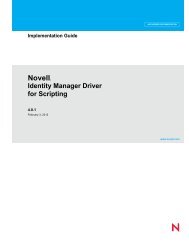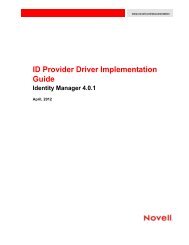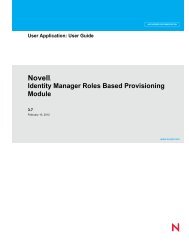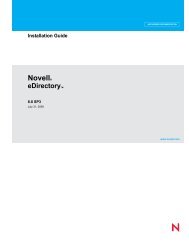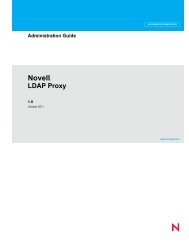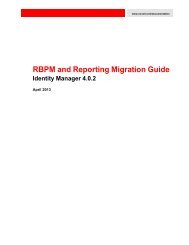Novell iManager 2.7.5 Administration Guide - NetIQ
Novell iManager 2.7.5 Administration Guide - NetIQ
Novell iManager 2.7.5 Administration Guide - NetIQ
You also want an ePaper? Increase the reach of your titles
YUMPU automatically turns print PDFs into web optimized ePapers that Google loves.
4<br />
4Browsing Objects<br />
<strong>iManager</strong> lets you manipulate and manage directory objects. There are two paradigms for doing this.<br />
First, you can browse for and select the objects with which you want to work, and then specify the<br />
task you want to perform on those objects (object‐then‐task.) Second, you can select the task you want<br />
to perform, and then specify the objects to which you want to apply the task (task‐then‐object.) Either<br />
way of doing things is valid, and <strong>iManager</strong> lets you use the method with which you are most<br />
comfortable.<br />
<strong>iManager</strong> provides the Object View for those from the object‐then‐task school, and the Object Selector<br />
for those from the task‐then‐object school. The Object Selector is used extensively in the Roles and<br />
Tasks view. For more information, see Chapter 5, “Roles and Tasks,” on page 33.<br />
This chapter includes the following sections:<br />
• Section 4.1, “Using the Object View,” on page 24<br />
• Section 4.2, “Using the Object Selector,” on page 29<br />
NOTE: <strong>iManager</strong> 2.7 now supports browsing and selecting objects in an NCP‐enabled file system.<br />
Access file system objects through Server and Volume objects in the directory tree.<br />
The ability to browse and select file system objects is available from both the Object View and the<br />
Object Selector. However, the actual tasks available for file system objects is provided by the NSS<br />
<strong>iManager</strong> plug‐in, which is available separately.<br />
Regardless of the tool you are using, remember the following guidelines when specifying object<br />
names:<br />
• If the following characters are part of a dotted eDirectory name, escape them with a backslash<br />
(\). You donʹt need escape characters in most values, but you do need them when the name is a<br />
distinguished name or relative distinguished name.<br />
• Period (.)<br />
• Equal sign (=)<br />
• Plus sign (+)<br />
• Backslash (\)<br />
• If the following characters are part of a name you want to specify in a search, escape them with a<br />
backslash (\):<br />
• Asterisk (*)<br />
• Backslash (\)<br />
For example:<br />
• To search for all objects containing a period, use = *.* as the search filter<br />
• To search for all objects containing a plus, use = *+* as the search filter<br />
• To search for all objects containing a backslash, use = *\\* as the search filter<br />
Browsing Objects 23




